Chess
Notes
Edward Winter
When contacting us by e-mail, correspondents are asked to include their name and full postal address and, when providing information, to quote exact book and magazine sources. The word ‘chess’ needs to appear in the subject-line or in the message itself.
| First column | << previous | Archives [78] | next >> | Current column |
6884. ‘While There’s Check There’s Hope’
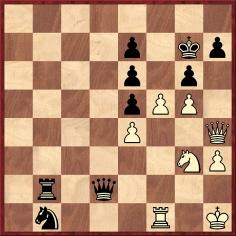
White, to move, resigned.
From page 92 of the 1 April 1949 issue of Chess World:

6885. Alekhine in Pilsen (C.N. 6860)
Jan Kalendovský (Brno, Czech Republic) has sent us, courtesy of Miloslav Míč, a photograph which was taken during the simultaneous display by Alekhine discussed in C.N. 6860 (Pilsen/Plzeň, 1 February 1943):

6886. Hays and Hall

As regards copying, who first pointed out publicly that Combination Challenge! by L. Hays and J. Hall (Dallas, 1991) was guilty of wholesale plundering from Fred Reinfeld’s 1955 book 1001 Brilliant Chess Sacrifices and Combinations?
We recall, but cannot currently trace, a 1990s magazine item which criticized Hays and Hall for misappropriating so much of Reinfeld’s work. One of the authors subsequently responded that, in fact, a (relatively small) number of the positions came from elsewhere, which prompted the magazine to make a sarcastic remark to the effect, ‘Well, that’s all right then’. Where did those exchanges appear?
The Reinfeld volume has also been published under the titles 1001 Chess Sacrifices and Combinations and 1001 Winning Chess Sacrifices and Combinations. No players’ names or venues were given, but many famous games were included. See, for instance, page 137 (and page 4 of the Hays/Hall monstrosity, which had a total of 1,154 positions).
6887. Albert T. Leise (C.N.s 6561 & 6628)
Jeffrey Staines (Elizabeth, NJ, USA) informs us that he owns this postcard:
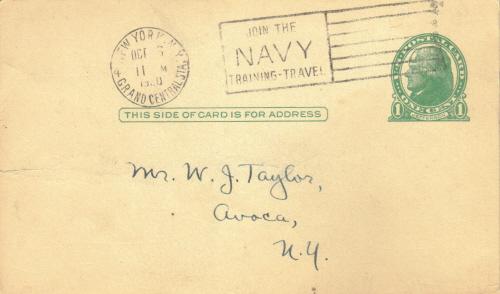
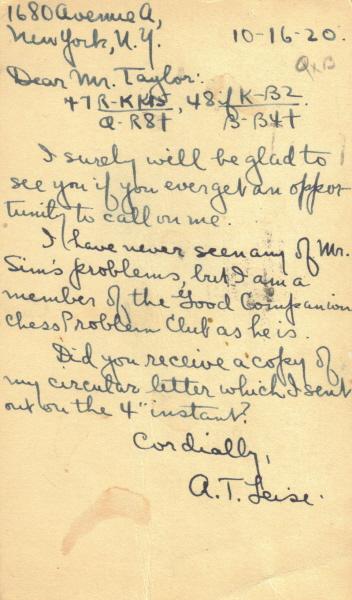
We note that the final phase of the game was given on pages 212-213 of the December 1921 American Chess Bulletin:
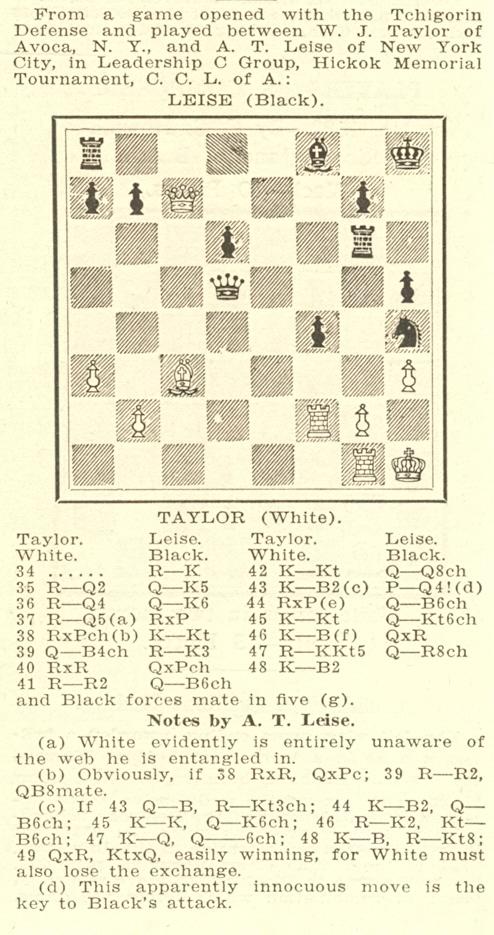

A further specimen of Leise’s play comes from page 38 of the February 1923 American Chess Bulletin:
Albert T. Leise – Albert BardenCorrespondence
Giuoco Piano
1 e4 e5 2 Nf3 Nc6 3 Bc4 Bc5 4 c3 Nf6 5 d4 exd4 6 cxd4 Bb4+ 7 Nc3 Nxe4 8 O-O Bxc3 9 d5 Ne5 10 bxc3 Nxc4
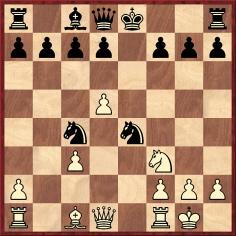
11 Qd4 Ncd6 12 Qxg7 Qf6 13 Qxf6 Nxf6 14 Re1+ Kf8 15 Bh6+ Kg8 16 Re5 Nfe4 (‘If 16...Nde4, the Handbuch gives 17 Re1, but instead as O. Frink Jr showed me several months before this game began, White has a problem-like mate in three, viz. 17 Nd2! d6 18 Nxe4, etc.’ – Leise.) 17 Re1 f5 18 Re7 b5 19 Nh4 Bb7 20 Rg7+ Kf8 21 Rxh7+ Resigns.
6888. Shoes
From Philip Wong (Wilmette, IL, USA) comes the information that there is a ‘Checkmate’ collection of shoes from the company Barker, with models which include the names of Fischer, Spassky, Karpov and Topalov. An Internet search for such words will lead to a number of websites, some of which have illustrations showing chess positions on the soles.
Our correspondent asks about other instances of non-chess articles being named after chessplayers. As regards clothing, page 225 of David Lawson’s biography of Morphy reproduced an advertisement for The Morphy Hat (‘1859 – A new and novel style of straw hat’). C.N.s 4177 and 4187 referred to merchandise allegedly on sale in Prague in the 1930s, including ‘Salo Flohr collars’ and ‘Flohr slippers’. However, the source for that information was only Koltanowski.
Page 41 of XIV. Schach-Olympiade Leipzig 1960:
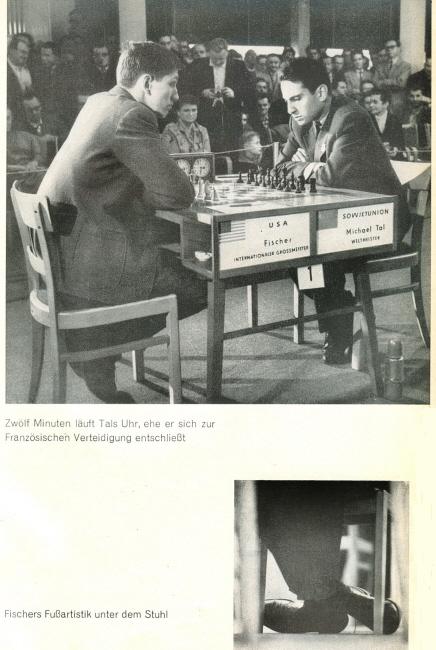
6889. Masters of the Chess Board
C.N. 5679 drew attention to this strange passage on page 173 of B.J. Horton’s Dictionary of Modern Chess (New York, 1959):
‘Réti viewed chess as a struggle between two personalities and as his biographer, Horace R. Bigelow, stated, Réti “often deliberately made bad moves, or inferior moves, if in his judgment these tended to lure his opponent to destruction”.’
Horton, we add now, had misconstrued a section on page v of Bigelow’s Introduction to the 1932 US edition of Réti’s Masters of the Chess Board:
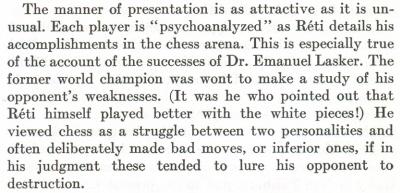
At the start of the final sentence the word ‘He’ obviously refers to Lasker, not Réti.
Lasker’s reaction to some of Réti’s comments about him appeared in a letter on pages 357-358 of the 14 May 1936 issue of CHESS. It was reproduced in C.N. 2516; see pages 404-405 of A Chess Omnibus.
Bigelow’s Introduction to Masters of the Chess Board also included, on page ix, this paragraph about Réti:
‘As a composer of endgames he was in a class by himself among the masters. His “positions” were all apparently simple and “natural-looking”, but in the words of the then world champion, José Raúl Capablanca: “Réti’s endings are the only ones worth solving and the only ones to give me trouble.”’
We have no information as to the source of the remark attributed to Capablanca.
The Cuban wrote briefly about Réti’s book on page 82 of A Primer of Chess (London, 1935):
‘There are besides some interesting books of various kinds that are very useful to the expert or near-expert. One of the most interesting is Réti’s Masters of the Chess Board. I refer only to the part written by Réti himself. He died before the book was finished and someone else wrote the last part of the book, which cannot be compared with the first.’
Capablanca’s criticism may mystify readers of the British edition of Réti’s book (London, 1933). It ended with a 23-page section on Alekhine, whereas in the US edition that chapter was followed by further material: brief sections on Grünfeld, Euwe, Sämisch, Colle and Torre, with a single annotated game per master and no discussion. For example, page 420 began:

Page vii of Bigelow’s Introduction (which was also absent from the British edition of the book) supplied an explanation:
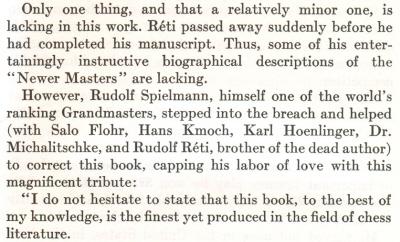
We do not read that text as justifying any suggestion of ghosting.
The same helpers had been acknowledged by Richard Réti’s brother in his Afterword on pages 395-396 of the German-language edition, Die Meister des Schachbretts (Mährisch-Ostrau, 1930).
The British and US editions (which, textually, were by no
means identical) stated on the title page ‘Translated from
the German by M.A. Schwendemann’. (C.N. 4892 asked,
without result, whether any information was available
about him.) Page v of the British edition gave a brief
note on Réti by Julius du Mont, but the latter had far
more involvement in the English-language editions than
might be thought. Details were supplied by du Mont himself
in correspondence with Granville Whatmough, who quoted
from it on page 196 of the July 1965 BCM (in D.J.
Morgan’s Quotes and Queries column):
‘The English edition of Réti’s book Masters of the Chess Board is entirely by him. The German edition has a few small chapters on Grünfeld, Euwe, Sämisch, Colle and Torre. These consist of one game each, the article describing their style of play is in each case missing in the German edition. I thought it best to leave out the whole thing because the inclusion of these with the exception of Euwe would debilitate Réti’s explanation why some great players, including English ones, were not included, namely that they had no influence on the history and the development of the game.
I would like to add that the translation which the British publishers bought from the Americans proved hopelessly inadequate, and I was commissioned by them to effect a thorough revision, in other words, translate the translation. I may say that the American publishers subsequently bought and adopted my revision.
Of course, the remarks of Capablanca referring to “the last part of the book”, etc. refer to that part in the German edition which was omitted in the English one.’
The above-mentioned ‘explanation’ by Réti about the selection of players was on, respectively, pages 216 and 107 of the US and British versions. The editorial involvement of du Mont in the English-language volumes is confirmed on page 248 of the June 1933 BCM, which stated that he had ‘revised the translation and annotations’. How thorough he was is another matter. Near the end of the introductory material in the Alekhine chapter it was stated that Alekhine wrote a book entitled My Hundred Best Chess Games. The equivalent erroneous claim (Meine hundert besten Schachpartien) had appeared on page 340 of the German original of Réti’s book, but du Mont might have been expected to correct the title in English, given that he was the co-translator of the Alekhine anthology in question, My Best Games of Chess 1908-1923 (London, 1927).
Euwe, for his part, had a longstanding grievance over Réti’s book. On page 21 of the April 1982 Chess Life Walter Meiden recalled concerning his co-author and friend:
‘He never said much about the opinion of others of his chess performance, but he deeply resented the fact that Richard Réti had almost decided not to include him in his Masters of the Chess Board.’
It may be wondered what grounds Euwe had for his belief about Réti’s intentions.
6890. Still incorrigible
Under the heading ‘Incorrigible’ the following item appeared in C.N. 3216 (see also page 249 of Chess Facts and Fables):
‘Wilhelm Steinitz did not become World Champion until he was over 58 years old, on May 26, 1894.’
That is what Eric Schiller persistently claims. We drew attention to it in C.N. 2241 (i.e. on page 89 of the 1/1999 New in Chess). Far from correcting his spectacular gaffe, Schiller subsequently posted it at a second website, as we noted in C.N. 2302 – see page 98 of the 5/1999 New in Chess. Yet even then Schiller refused to make a correction, so in C.N. 2468 (page 105 of the 1/2001 New in Chess) we mentioned the matter a third time.
What, then, is the situation today, all these years later? It will surprise no-one to learn that Schiller’s website still affirms:
‘Wilhelm Steinitz did not become World Champion until he was over 58 years old, on May 26, 1894.’
That summary was written in 2004. Today, a dozen years after we first pointed out the spectacular gaffe, the same claim about Steinitz is still online, under the title ‘Oldest World Champion’ in a signed article by Schiller at a website which states that it is supervised by him: Chesscity.com.
6891. Group picture (C.N. 6876)
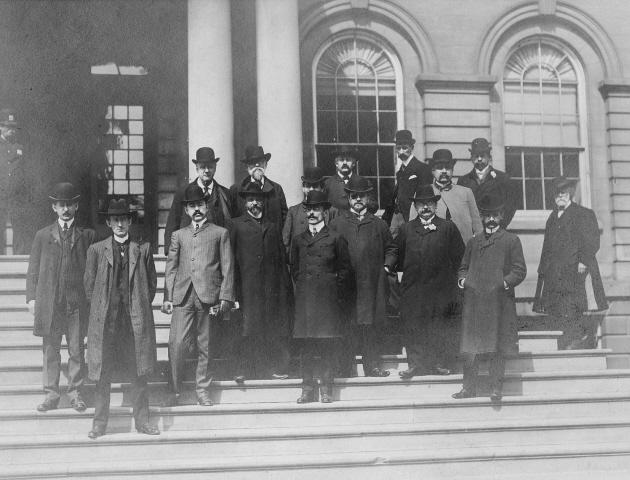
We offered a book prize for the best attempt by a reader to identify the above figures. It was a difficult task, even though some masters, such as Marshall, Janowsky, Teichmann and Schlechter, are immediately recognizable and even though, as will be seen, the photograph concerns a famous tournament.
The winner of our contest is Dominique Thimognier (Fondettes, France), and we can do no better than paraphrase his excellent entry, which identifies virtually the entire group.
The photograph shows players in, and organizers of, Cambridge Springs, 1904. Newspaper reports of the time mentioned by Mr Thimognier relate that eight players (Lasker, Chigorin, Teichmann, Janowsky, Schlechter, Marco, Lawrence and Marshall), accompanied by the treasurer of the Carlsbad Club, Victor Tietz, arrived in the United States on the Pretoria. (Mieses followed a few days later on the Graf Waldersee.) This account of their reception appeared on page 16 of the New York Daily Tribune, 19 April 1904:

Mr Thimognier also points out that an Internet search confirms that the building in the photograph is the New York City Hall. He offers the following key:
Foreground (left to right): J. Finn, F.J. Marshall, J.F. Barry, M. Chigorin, D. Janowsky, R. Teichmann, V. Tietz, C. Schlechter and J.M. Hanham.
Background (left to right): H. Ridder, I.L. Rice, Em. Lasker, H. Cassel, T.F. Lawrence, G. Marco and N.N. (L. Heller?).
6892. Seeing/looking ahead
From page iv of Réti’s Masters of the Chess Board (New York, 1932), in H.R. Bigelow’s Introduction:
‘There is an anecdote told to the effect that Réti was once asked how far ahead he had to calculate in a serious contest. “Only two moves!”, he replied to the astonished inquirer. This is an exaggeration, of course, but it is certainly true that once the principles of the selected opening are properly grasped, the correct sequence of moves becomes more or less automatic.’
From the Introduction (page vii) to Lessons in Chess Strategy by W.H. Cozens (London, 1968):
‘How many moves ahead can you see?
This question is frequently put to chessmasters. Réti’s famous reply “Usually not one!” is often regarded as a witticism, but after a little thought about the complex structure of chess one may perhaps conclude that he was speaking something alarmingly near to literal truth.’
How far back can any such alleged remark by Réti be traced? For further variations on the theme, involving Capablanca, Jaffe, Janowsky and Sir George Thomas, see pages 220-222 and page 325 of Kings, Commoners and Knaves, as well as C.N.s 4483, 5320 and 5375.
6893. Rosebault in court
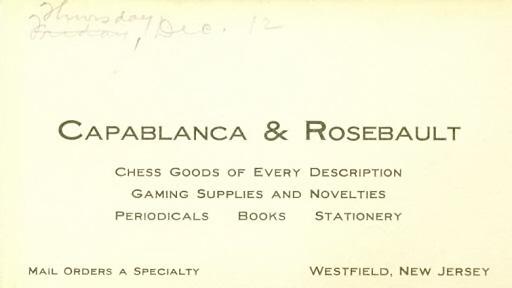
Olimpiu G. Urcan (Singapore) has provided a series of cuttings concerning a 1909 court case in which Frederick Rosebault was charged with disorderly conduct at the Brooklyn Chess Club. They have been added to The Mysterious Frederick D. Rosebault.
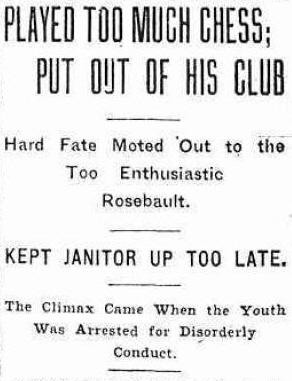
6894. Fabergé
C.N.s 3105 and 3123 offered information about wine goblets (old Russian style) presented to the masters at St Petersburg, 1914. (See Chess Jottings.)
Two Fabergé chess sets, dating from 1905 and 1915, are discussed, with fine photographs, on pages 8-13 of Chess Masterpieces (subtitle: ‘One thousand years of extraordinary chess sets’) by George Dean with Maxine Brady (New York, 2010).
6895. Oliphant
Carel or (Carl) Naret Oliphant was mentioned in C.N.s 5408 and 5416 in connection with Amsterdam, 1851. Now, Thomas Niessen (Aachen, Germany) reports that a Burke’s Peerage and Gentry webpage includes information on ‘a Dutch wigmaker from Leyden’ of the same name.
Can it be demonstrated beyond doubt that they were the same person?
6896. N.W. Banks
Two newspaper cuttings concerning Newell Williams Banks have been submitted by Russell Miller (Vancouver, WA, USA):
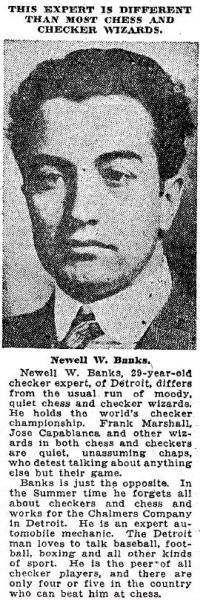
The Oregonian, 23 February 1917, page 19

Dallas Morning News, 24 February 1958, part 2, page 6.
6897. Direct speech
There may never have been a chess book, even by Dimitrije Bjelica, with more direct speech than Bobby Fischer vs. the Rest of the World by Brad Darrach (New York, 1974). The matter was touched on in a recent ChessBase article of ours.
It brings to mind the brilliant, though possibly untranslatable, remark by François Mitterrand about Jacques Attali: ‘Il a le guillemet facile.’
6898. Seeing/looking ahead (C.N. 6892)
Luc Winants (Boirs, Belgium) notes this passage on page 5 of Réti’s Modern Ideas in Chess (London, 1923):
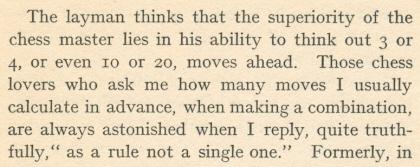
We add the text from page 6 of the original German edition, Die neuen Ideen im Schachspiel (Vienna, 1922):
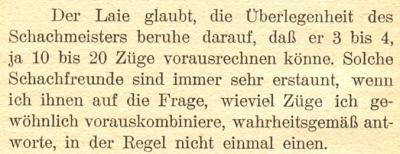
6899. Postcards (C.N.s 6759 & 6818)
Henk Smout (Leiden, the Netherlands) draws attention to a webpage featuring chess-related postcards. It is strange to see those of J. Rotgans dated as late as 1930.
6900. Capablanca photographs
A set of unknown photographs of Capablanca at the website of the University of Miami Libraries is pointed out by Christian Sánchez (Rosario, Argentina).
6901. Premature announcement of Steinitz’s death
In connection with Chess and Untimely Death Notices, Mr Sánchez mentions this report in the New York Times of 22 February 1897:
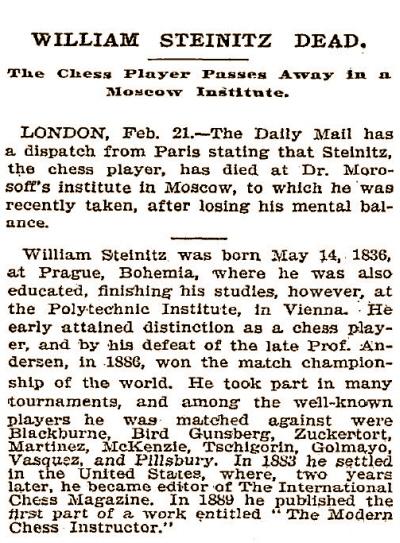
We recall that Tarrasch mentioned the premature news reports about Steinitz in the essay ‘Der Fall Pillsbury’ in his book Die Moderne Schachpartie (page numbers vary according to the edition):
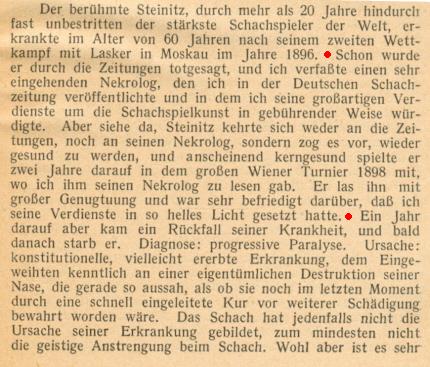
In fact, there was no ‘obituary’ of Steinitz in the Deutsche Schachzeitung of 1897, a magazine then edited by Tarrasch. See, however, the extensive selection of Steinitz’s best games on pages 70-85 of the March 1897 issue. The feature began with a note stating that reports of the former world champion’s death were untrue.
6902. Pillsbury article
Peter de Jong (De Meern, the Netherlands) sends this article from page 334 of the 14 March 1896 edition of Black and White:
‘Ladies at Chess
By H.N. Pillsbury
Ladies have latterly invaded almost all the fields hitherto occupied by men, but at the beginning of last year they had not yet gone so far as to form a chess club for themselves. That was a state of affairs which only needed to be noticed in order to be remedied, and so the Ladies’ Chess Club came into existence in the month of January 1895. In the beginning it did not include many members, and the members, instead of spending their afternoons in paying calls, used to meet at one another’s houses and study the Royal Game. But the institution was one of the things which, since they meet a long-felt want, are bound to have a rapid success, and before long the list of members had swelled to such dimensions that it was felt to be necessary to have a club-room. This was found, and Monday evenings were devoted to the game, the afternoon visits being still kept up, until the members obtained their present premises, where the weekly meeting is held from three to half-past ten. At the Hastings Tourney, in the section for ladies, no less than seven of the offered prizes were won by LCC members, and they have done very well in their 23 matches against various London clubs. ’Tis true, they have only thrice scored victories, and only twice drawn the match; but, upon the other hand, it must be remembered that they were playing against those who have had vastly more experience than themselves. They might reasonably enough have demanded odds, but they understood that in such a pursuit as this to take a beating intelligently is to go some distance towards gaining the power to inflict a beating at some future encounter, and so they have played on equal terms.
Moreover, although two victories out of 23 matches is not a high rate of success, the record looks better if you say that in the first 20 matches the games lost were 106½, those won 79½. The success of the club as an institution has gone on increasing, and the members already number close upon a hundred. The founders have received the pleasant flattery of imitation, and their happy idea has been copied in Paris, Brooklyn, New York and other cities. There is even talk of a cable match betwixt the club and one or other of the American institutions. The present premises are at 103 Great Russell Street. Lady Newnes is President, while Mrs Bowles, as match captain, has done much to secure the successes which have been chronicled. She is also, for the present, secretary and treasurer. Miss Field is the first lady who has essayed the difficult task of playing blindfold against several opponents simultaneously. Mrs Fagan has played with success in the matches, and is an excellent composer of problems. Lady Thomas, who was the Hastings champion in the Ladies Section, is among the vice presidents. She has played as many as eight games simultaneously. One of the most promising members is Mrs James, who only began to play the game a year ago, and has already won prizes. A tournament has been proceeding with 32 competitors; and the announcement of a 50 players aside match between the Ladies Club and the Metropolitan is a testimony to the energy and enthusiasm displayed.’
An additional paragraph appeared on page 356 of Black and White, 21 March 1896:
‘The Ladies’ Chess Club concerning which Mr Pillsbury lately wrote in Black and White has added another to its list of successes, defeating the Metropolitan Club by 25½ games to 24½. Thirty of the ladies insisted on playing on equal terms with their opponents, but the remaining 20 accepted odds: six of their opponents surrendering a queen, and the others a rook or a knight. Mrs Arthur Smith writes, concerning Mr Pillsbury’s article, that there was a Ladies’ Chess Club in Brighton from 1881 till 1894, when it was merged into the St Ann’s Club.’
Pillsbury’s article was accompanied by photographs of Lady Thomas, Mrs James, Miss Field, Mrs Fagan and Mrs Bowles. The follow-up item had a drawing ‘Ladies at Chess in London’ by J. Barnard Davis.
6903. An unusual gambit
In a ten-board blindfold exhibition in Milan on 25 March 1923 Alekhine lost a game to L. Morelli, who played the gambit 1 e4 d5 2 exd5 c6 3 dxc6 Qc7 4 cxb7 Bxb7. For the full score see page 187 of the Skinner/Verhoeven book on Alekhine.
We note that some two years previously Morelli had played the same opening, with less success:
E. Mildmay – Luca MorelliMilan, 1921 (?)
Center Counter Game
1 e4 d5 2 exd5 c6 3 dxc6 Qc7 4 cxb7 Bxb7
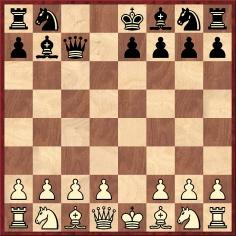
5 d4 Nf6 6 c3 Nc6 7 Be3 e5 8 Nf3 e4 9 Nfd2 Bd6 10 Nc4 Bxh2 11 g3 Bxg3 12 fxg3 Qxg3+ 13 Bf2 Qc7 14 Nbd2 O-O-O 15 Bh3+ Kb8 16 Qb3 Qf4 17 Rg1 Ka8 18 Bg3 Qh6 19 Bg2 e3 20 Ne4 Nxd4

White announced mate in three: 21 Qxb7+ Kxb7 22 Nc5+ Kc8 23 Bb7 mate.
Our source is pages 74-75 of the May 1921 Schweizerische Schachzeitung:
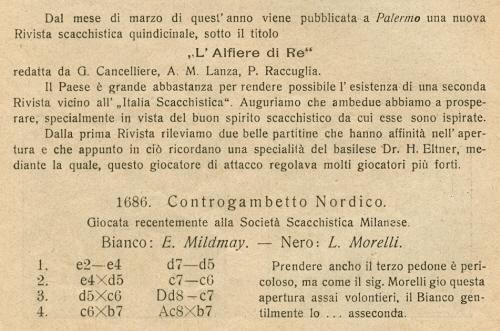

6904.
Nunnally Johnson
In the light of Johnson’s article on the New York, 1924 tournament (C.N. 6881) we hoped to find some references to chess in The Letters of Nunnally Johnson selected and edited by Dorris Johnson and Ellen Leventhal (New York, 1981). The only (passing) mention of the game that has been found in the collection (which covers his correspondence from 1944 to 1976) is on page 249, in a letter dated 8 November 1974 from Johnson to Tom Dardis concerning F. Scott Fitzgerald:
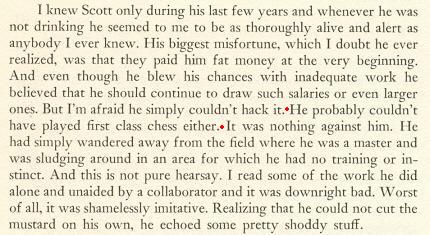
In Hollywood, Johnson worked with and frequented a vast muster of celebrities. The photograph below, taken during the shooting of How to Marry a Millionaire (1953), features, from left to right, Nunnally Johnson, Marilyn Monroe and Jean Negulesco:
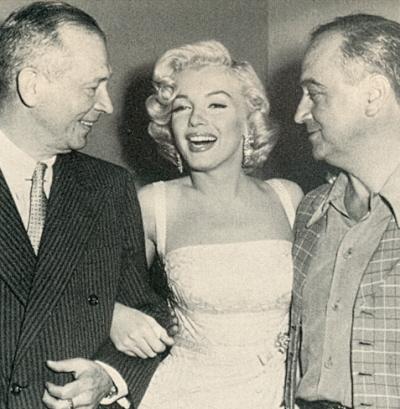
6905. Opposition (C.N. 6869)
Eduardo Bauzá Mercére (New York, NY, USA) asks:
‘When, where and by whom were the concepts of a) “opposition” and b) “diagonal opposition” first mentioned?’
6906. Charles Dickens and chess
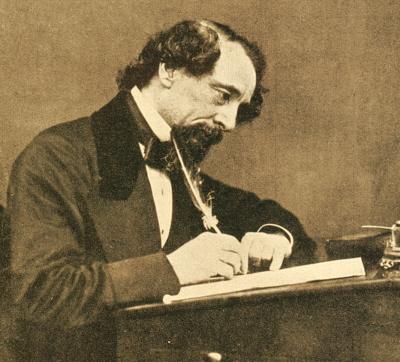
Charles Dickens
Some references:
- ‘Charles Dickens as a Chessplayer’, on page 12 of Lasker’s Chess Magazine, May 1905. A story stated to be from the Baltimore Sunday News about Dickens and Victoria Tregear, who allegedly played chess with him.
- ‘Charles Dickens and Chess’, on page 533 of the Chess Amateur, February 1912. A brief report about Dickens giving money to a 12-year-old boy whose workmanship in making a chess board with a hack knife and saw had impressed him.
- ‘The Falkbeer Counter-Gambit’, on pages 394-396 of the BCM, December 1916. A game (Piper v Davie) annotated with quotations from The Pickwick Papers.
- ‘Chess in Films’, on page 92 of Chess World, 1 April 1949. Reference to a chess scene in the 1948 film Oliver Twist which is not in the novel. The item asked whether there were any references to chess in Dickens’ work.
- ‘Dickens on Chess’, on page 243 of Chess World, 1 October 1949. A reply to the previous item from T.R. Dawson, quoting references to chess in The Pickwick Papers, Dombey and Son, The Detective Police and The Battle of Life.
- ‘Who was Victoria Tregear?’ by C. Ravilious on pages
52-53 of CHESS, December 2005. A detailed
examination of the question.
The item from Lasker’s Chess Magazine (1905) was reproduced on pages 285-286 of The Treasury of Chess Lore by F. Reinfeld (New York, 1951). A complication is that we see Internet pages stating that the Baltimore Sunday News ceased publication in the 1890s. Has anyone ever traced the newspaper’s original report regarding ‘Victoria Tregear’?
Many writers have placed reliance (rashly, we feel) on the item published in Lasker’s Chess Magazine. It was, for instance, the sole basis for an entry on Dickens in B.J. Horton’s Dictionary of Modern Chess (New York, 1959).
6907. Tile
Jan Koppenaal (Noordwijk, the Netherlands) possesses a cloisonné tile (13cm x 13cm) manufactured by De Porceleyne Fles in Delft. It states ‘1935 – Dr Max Euwe – wereld kampioen – schaken’:
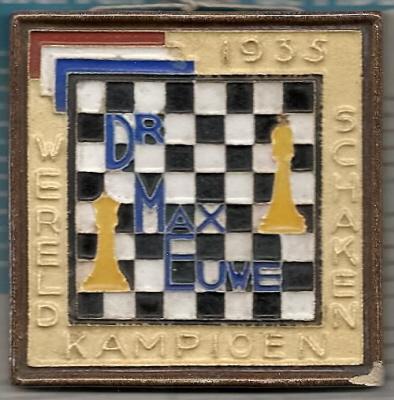
6908. Italian postcard
The same correspondent asks whether the players in this photograph on an Italian postcard in his collection can be identified:
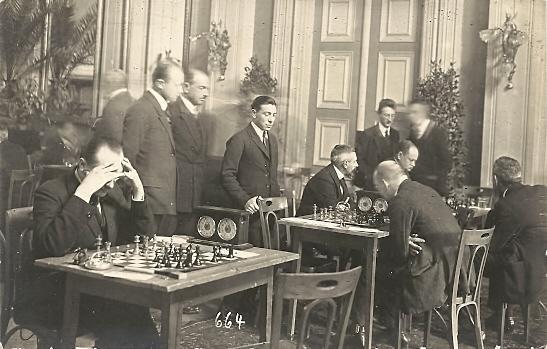
The reverse side of the card specifies: ‘Photo E. Joffé; Merano’.
6909. Charles Dickens and chess (C.N. 6906)

Russell Miller (Vancouver, WA, USA) has
found an article ‘From Palace to Hovel’ by Miller
Hageman which has the subtitle ‘The Strange Story of
Victoria Tregear, Friend of Charles Dickens’. It was
published in the Dallas Morning News of 21 June
1891, part two, page 16. The references to chess are in
column three.
Caution is clearly still required with this curious matter, and we have created a feature article Charles Dickens and Chess for reporting on further investigations and discoveries.
6910. Two Marshall v Napier games
Page 436 of the December 1897 American Chess Magazine had this game from the Brooklyn Chess Club Championship, then in progress:
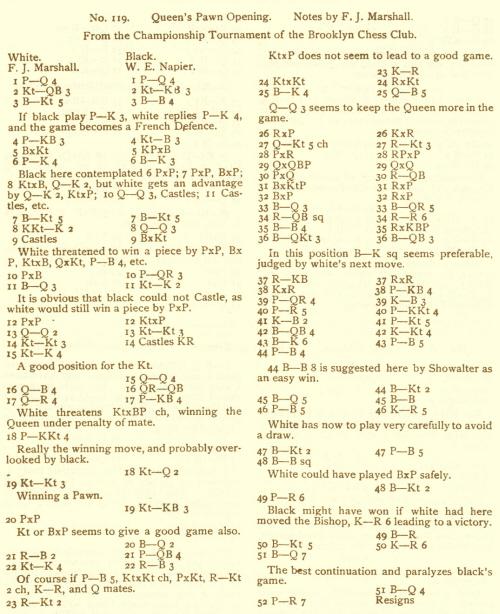
The game was included, also with Marshall’s annotations, on pages 170-171 of Young Marshall by John S. Hilbert (Olomouc, 2002), which noted that it had been played in round one, at the very beginning of December 1897. Another source mentioned was the Brooklyn Eagle of 4 December 1897. Page 267 of the book gave the crosstable of the single round-robin tournament, played in 1897-98. The joint winners were Marshall and Napier, after which Marshall was victorious in a short play-off match in February-March 1898. See also pages 66-67 of another work by Dr Hilbert, Napier The Forgotten Chessmaster (Yorklyn, 1997).
It was therefore a surprise to receive from John Blackstone (Las Vegas, NV, USA) this cutting from page 5 of the New York Evening Post, 10 December 1897:
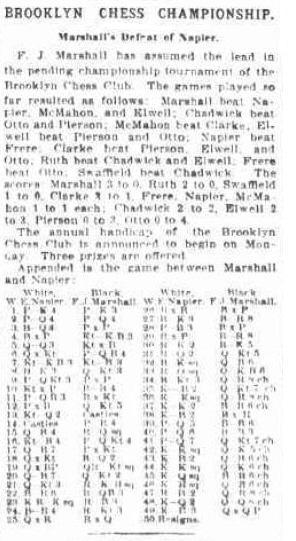
The item is too faint for us to give a transcription with full confidence, but how, in any case, is the existence of two entirely different games to be explained?
6911. Capablanca photographs
The front cover of Time, 7 December 1925:
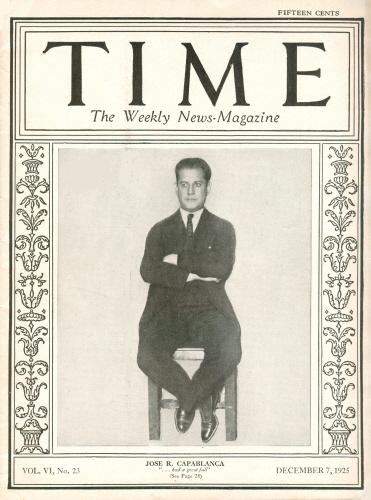
The photograph is merely a cut-out from a New York, 1924 group shot (given in C.N. 5372).
A fine portrait published around that time, although taken about a decade earlier, was in a Russian edition of Chess Fundamentals, i.e. the frontispiece of Osnovy shakhmatnoi igry (Petrograd, 1924):

This may be compared with the silhouette of the Cuban shown in C.N. 4113.
6912. ‘The equalizing injustice of chess’
From an annotation on page 156 of the May 1961 Chess Review, in the magazine’s postal section (conducted by Jack Straley Battell):
‘... or, in the more erudite language of Dr Tartakower, “The equalizing injustice of chess”.’
A passage on page 251 of The Chess Masters on Winning Chess by Fred Reinfeld (New York, 1960):
‘... Bernstein made a point of what he called “the equalizing injustice of chess”. By this he meant, presumably, that the apparent unfairness of such a loss is canceled by a sequence of blunders: the player who finally pays for a mistake has probably escaped punishment for earlier mistakes. In the long run, undeserved victories will balance out with undeserved losses. (Of course, the term “undeserved” raises problems, for a mistake deserves to be punished.)’
It is indeed to Bernstein that the phrase is usually ascribed. See, for instance, pages 178-179 of Chess for Fun & Chess for Blood (Philadelphia, 1942) and pages 75 and 94 of Chess Secrets I Learned from the Masters (New York, 1951), to mention two books by Edward Lasker.
Even so, the earliest citation that we can offer at present is from Edward Lasker himself (with no reference to Bernstein), in his annotations to a game on page 301 of the July 1913 BCM:

6913. Actually published

This text was actually published in a chess book, by an American writer.
6914. Quiz question
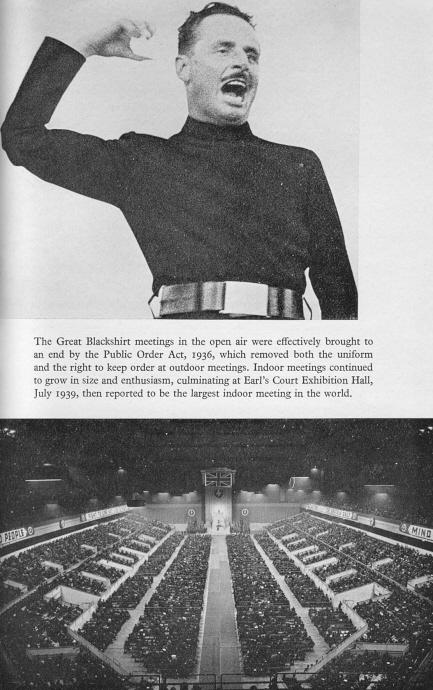
Against which (former) Prime Minister did this political leader play chess? (A clue is available in our feature article Chess Journalism and Ethics.)
6915. Delmar
Eduardo Bauzá Mercére (New York, NY, USA) offers this photograph of Eugene Delmar from an insert between pages 142-143 of Turf, Field and Farm, 8 August 1890:

6916. Two Marshall v Napier games (C.N. 6910)
A further contribution from Eduardo Bauzá Mercére:
‘The correct Marshall v Napier score is the one published in the American Chess Magazine and later reproduced in John S. Hilbert’s books on Napier and Marshall. It was also given in Hermann Helms’ column in the Brooklyn Daily Eagle, 4 December 1897, page 4. The game started on Thursday, 2 December and after adjournment was resumed the following day.
The score in the New York Evening Post of 10 December 1897 was the game between R.P. Messiter and H.I. McMahon (published in the Brooklyn Daily Eagle of 7 December 1897, page 5).’
On the basis of that Eagle item (as well as a clearer copy of the New York Evening Post column) our correspondent has provided the Messiter v McMahon game which the Post misattributed to Napier and Marshall:
1 e4 e6 2 d4 d5 3 Bd3 dxe4 4 Bxe4 Nf6 5 Qd3 Nxe4 6 Qxe4 c5 7 Nf3 Nc6 8 Be3 Qb6 9 b3 cxd4 10 Nxd4 Bc5 11 c3 Bxd4 12 cxd4 Qb4+ 13 Nd2 O-O 14 O-O f5 15 Qf4 Rd8 16 Nc4 b5 17 Qc7 bxc4 18 Qxc6 Bd7 19 Qxc4 Rab8 20 Qc7 Qb7 21 Qg3 Rf8 22 Bh6 Bc6 23 Rfe1 Rf6 24 Bf4 Rg6 25 Bxb8 Rxg3 26 Bxg3 Bxg2 27 Re3 Bh1 28 f3 Bxf3 29 Rxe6 Bh1 30 Re2 Be4 31 Rd2 Qb4 32 Be1 Qc3 33 Rad1 Qf3 34 Bg3 Qh1+ 35 Kf2 Qg2+ 36 Ke1 Qh1+ 37 Ke2 Bf3+ 38 Kf2 Bxd1 39 d5 Bf3 40 d6 Bc6 41 d7 Qg2+ 42 Ke1 Qe4+ 43 Kf2 Qf3+ 44 Ke1 Qe3+ 45 Kd1 Bf3+ 46 Kc1 Qc3+ 47 Rc2 Qa1+ 48 Kd2 Qd1+ 49 Kc3 Qxd7 50 White resigns.
6917. Statuvolent
From Time, 7 December 1925, page 29:
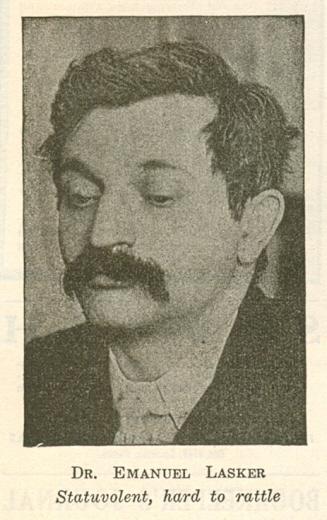
6918. Opposition (C.N.s 6869 & 6905)
From Harrie Grondijs (Rijswijk, the Netherlands):

‘In 1763 Lolli presented the above well-known basic pawn position. Barring exhaustive trial and error, its proper treatment assumes an understanding of the workings of the opposition and the right to move second in that situation.
The oldest instance of the word “opposition” that I have found so far is in Chapter V of the Traité théorique et pratique du jeu des échecs by “une société d’amateurs” (Paris, 1775), starting on page 264. The first example given, on page 266, is the above-mentioned Lolli position.’
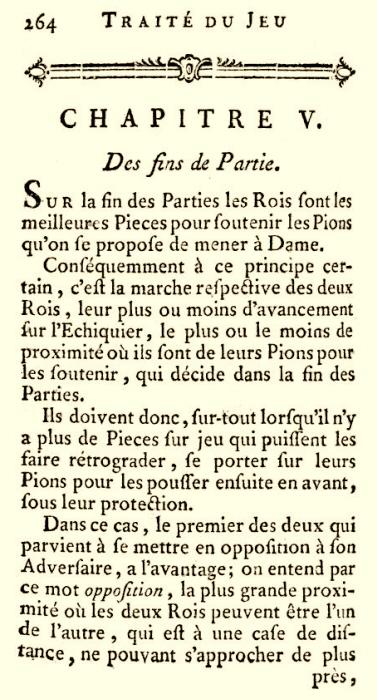
The full work is available on Google Books. From a check at the same site we note that the term ‘diagonal opposition’ was used on page 58 of Chess Exemplified by Charles Pearson (London, 1842).
Mr Grondijs, however, also mentions Chapais’ manuscript Essais analytiques (circa 1780):
‘It starts off with a complete theory of the opposition in ten pages, followed by about 100 pages with practical examples showing how to handle basic pawn endings. His theory stops short only of the wider notion of corresponding squares which was discovered and developed from the early twentieth century onwards. Chapais’ treatment includes the diagonal opposition, which he terms oblique opposition, and the so-called magic box.
I am currently working on a book which will disclose that part of the manuscript, and will make Chapais stand out as the hidden genius that he was.’
6919. Fiction
The back cover of a recent work of fiction, Paul Morphy: Confederate Spy by Stan Vaughan (Milwaukee, 2010):
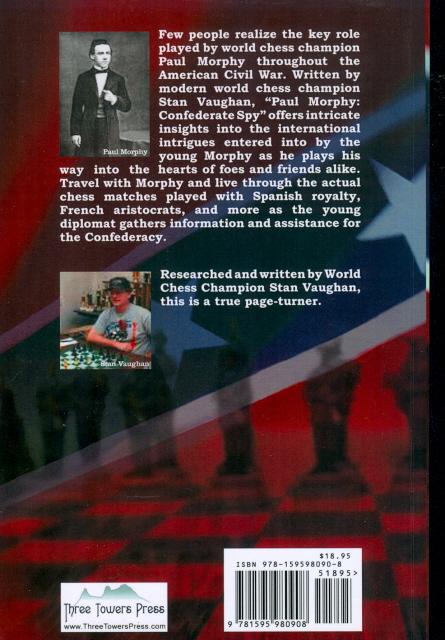
There is more information about the ‘modern world chess champion’ on the final page. It is stated, for instance, that S. Vaughan has the following titles and accomplishments:
- ‘the current World Chess Federation’s over the board Chess Champion (1999-2010)’;
- ‘a 30-time OTB champion of the American Chess Association (1981-2010)’;
- ‘former three-time WCCF World Correspondence Chess champion (1995-2007)’;
- ‘former Mensa two-time World Correspondence Chess champion’;
- ‘in 1988, the Chess Connection’s US Correspondence Chess Champion’;
- ‘gold medalist representing the USA in the 1980 International Student games held at Stillwater, Oklahoma’;
- ‘world record holder for most simultaneous correspondence games, playing 1300 at one time;
- ‘also claims the world blindfold simultaneous games record for games played without any recourse to sight of board or assistance of any game score notes’.
6920. Quiz question (C.N. 6914)
The Prime Minister against whom Oswald Mosley played chess was H.H. Asquith. From pages 94-95 of Mosley’s book My Life (London, 1968):
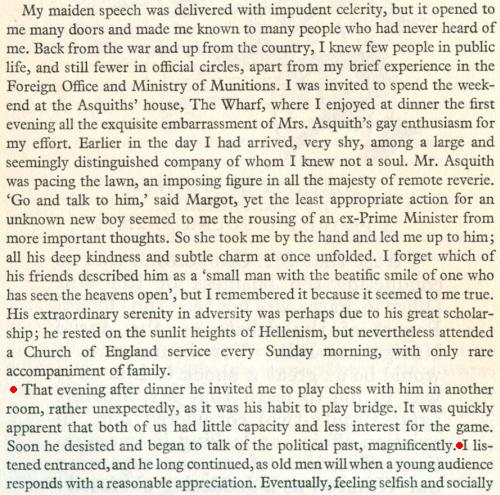

6921. New York, 1915
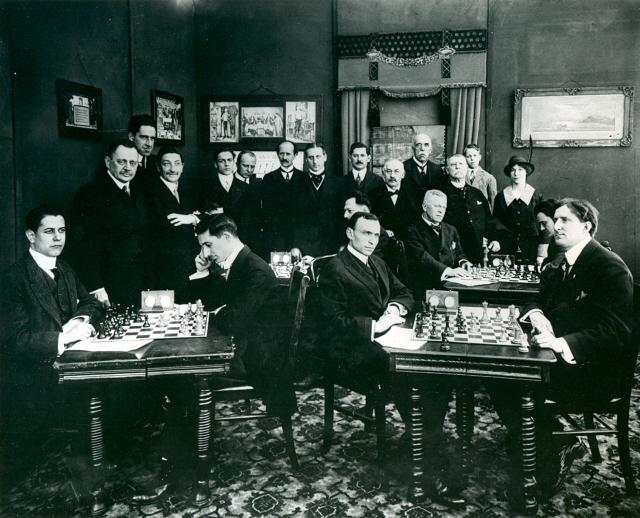
John Blackstone (Las Vegas, NV, USA) draws attention to page 3 of the Brooklyn Daily Eagle, 22 April 1915, which has a caption for the above photograph. The newspaper also reports on the film coverage featuring Capablanca, Marshall and other masters. See the addition to New York, 1915: A Chess Photograph.
6922. Christmas greeting card
An item about Géza Maróczy on page 26 of the February 1929 American Chess Bulletin:
‘Only recently the famous Hungarian sent out as a Christmas greeting card to his wide circle of friends the score of the Muzio Gambit which he won from Chigorin in the Vienna Gambit tournament of 1903.’
The game is well known, but does any reader have the greeting card?
Below is the best photograph of Maróczy in our collection:
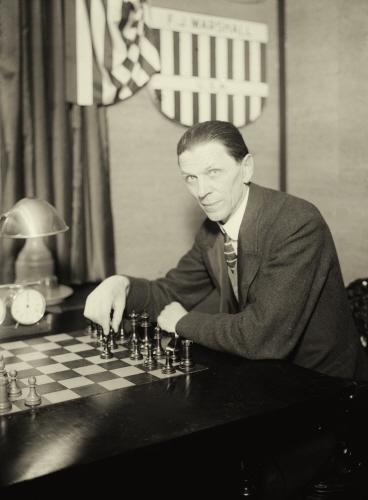
6923. Rice v N.N.
Information is sought about this well-known Rice Gambit game, purportedly won in New York in 1900 by Professor Rice, against an unidentified opponent:
1 e4 e5 2 f4 exf4 3 Nf3 g5 4 h4 g4 5 Ne5 Nf6 6 Bc4 d5 7 exd5 Bd6 8 O-O Bxe5 9 Re1 Qe7 10 c3 g3 11 d4 Ng4 12 Nd2 Qxh4 13 Nf3 Qh6 14 Qa4+ c6 15 Qa3 Nf2 16 Rxe5+ Be6 17 Kf1 Qh1+ 18 Ng1 Nh3 19 gxh3 f3 20 Bg5 Qg2+ 21 Ke1 f2+ 22 Kd2
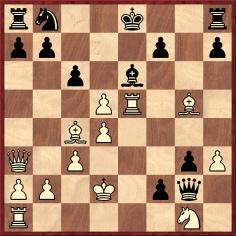
22...f1(N)+ 23 Kd3 Kd7 24 dxe6+ Kc7 25 Qe7+ Kb6 26 Qd8+ Rxd8 27 Bxd8 mate.
See, for instance, game 30 in One Hundred Chess Gems by P. Wenman (London, 1939), where it was described as ‘one of the best games ever played at [sic] the Rice Gambit’.
Below is the title page of the only Wenman book in our collection inscribed by him:
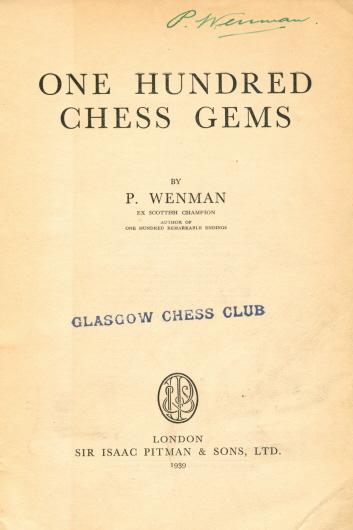
6924. Italian postcard (C.N. 6908)

Luca D’Ambrosio (Bolzano, Italy) comments that the photograph was taken on 12 February 1924 in the Kleiner Kursaal of the Kurhaus in Merano, during the seventh round of the tournament. On the left, Selesniev (White) is considering his 17th move (against Takács). At the next board Grünfeld is reflecting on his 17th move; Patay (absent from the board) has played 17 Qf2. At the final board is Spielmann, whose opponent that day (also unseen in the photograph) was Rubinstein. The figure standing before the Patay v Grünfeld game appears to be Colle.
Mr D’Ambrosio adds that he is currently finalizing a book on the Merano tournaments of 1924 and 1926 and that from the first event he is still seeking the complete game-scores of Selesniev v Rubinstein and Przepiórka v Grünfeld. More generally, does any reader have original score-sheets from either tournament, or information on the whereabouts of the papers of Adolf Seitz, the tournament director? Finally, details about other photographs taken in Merano in 1924 or 1926 would be appreciated.
We also thank Alan McGowan (Waterloo, Canada) and Dan Scoones (Port Coquitlam, BC, Canada) for contributions regarding the Italian postcard.
6925. Dodge v Houghteling
1 d4 d5 2 c4 e5 3 e3 exd4 4 Qxd4 Nf6 5 Nc3 Nc6 6 Qd1 Bf5 7 f3 Nb4 8 Qa4+ Qd7 9 Qxd7+ Kxd7 10 e4 dxe4 11 fxe4 Nxe4 12 Rb1 Nc2+ 13 Kd1 Nf2+ 14 Ke2 Bc5 15 Nf3 Bd3+ 16 Kd2 Be3 mate.
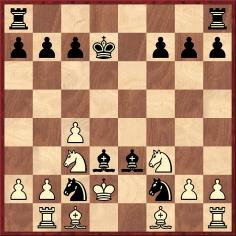
‘One of the most extraordinary mates ever given in actual play’ was the comment by Francis J. Wellmuth on pages 155-156 of The Golden Treasury of Chess (Philadelphia, 1943) regarding the game Dodge v Houghteling (‘Chicago, about 1905’). We should like to draw up a list of the game’s occurrences in print in the first decade of the last century, whether or not the players’ names were given. The following, for instance, appeared on page 227 of the May 1907 Chess Amateur:
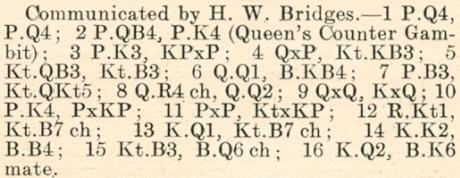
As regards the possible occasion of the game, page 139 of the December 1904 American Chess Bulletin referred to the ‘pending championship tournament’ of the Chicago Chess and Checker Club. The list of all 20 players included ‘Dodge’ and ‘J.R. Houghteling’. The result of the event was reported on page 232 of the June 1905 Bulletin. Only the top 12 participants were mentioned, and there was no reference to Dodge or Houghteling.
Houghteling was also a chess columnist and a problemist; concerning the latter activity see, for example, pages 42-43 of the February 1921 American Chess Bulletin. However, a further unresolved matter is why successive editions of Ranneforths Schach-Kalender (in particular, from around the period of the Great War until the mid-1920s) had an entry for T. Houghteling. The address was ‘1729 N. 42 Ave., Chicago, Ill.’.
6926. Pilnik v Fischer
From page 32 of My 60 Memorable Games by Bobby Fischer (New York, 1969):

Horacio Paletta (Buenos Aires) remarks that Herman Pilnik had gone to live in Argentina many years before the 1939 Olympiad, and that in any case he was not a participant in that event.
We note that Pilnik was named as one of the ‘elementos
nuevos’ on page 190 of the July-August 1933 issue of
El Ajedrez Americano, which gave two of his games
(against Valentín Fernández Coria and Roberto Grau) from
the Buenos Aires, 1933 tournament.
A photograph from page 308 of the October 1938 issue of
the Argentinian magazine, with Pilnik standing second from
the right:
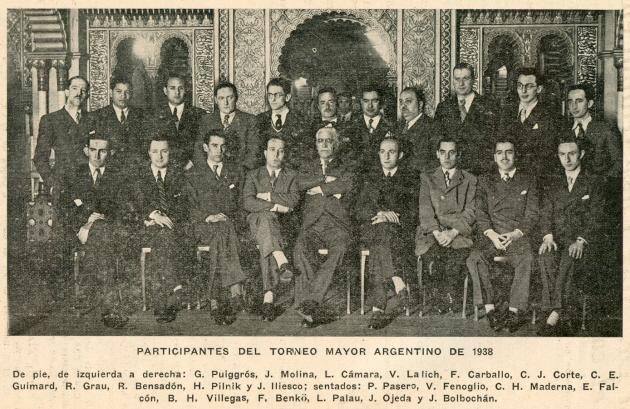
6927. Pilnik inscriptions
Two inscriptions by Herman Pilnik from our collection are presented, the first coming from the 32-page programme for the 1945 Pan-American Chess Congress in Hollywood:
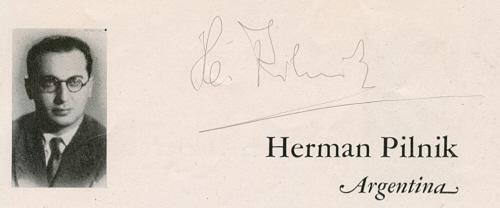
Secondly, a dedication by Pilnik to Ed Edmondson, in a book on the 1972 world championship match for which Pilnik supplied the annotations, Bobby: El triunfo de una Obsesión by Luciano W. Cámara (Buenos Aires, 1972):
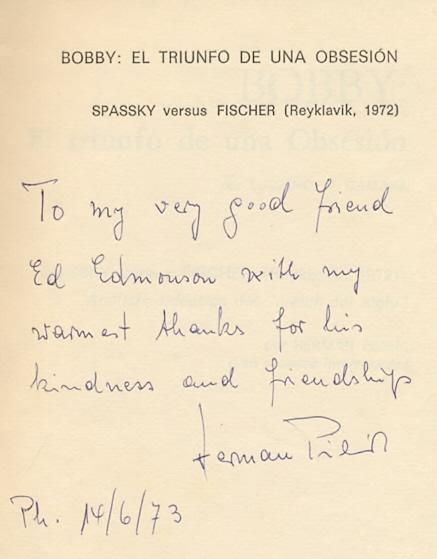
| First column | << previous | Archives [78] | next >> | Current column |
Copyright: Edward Winter. All rights reserved.